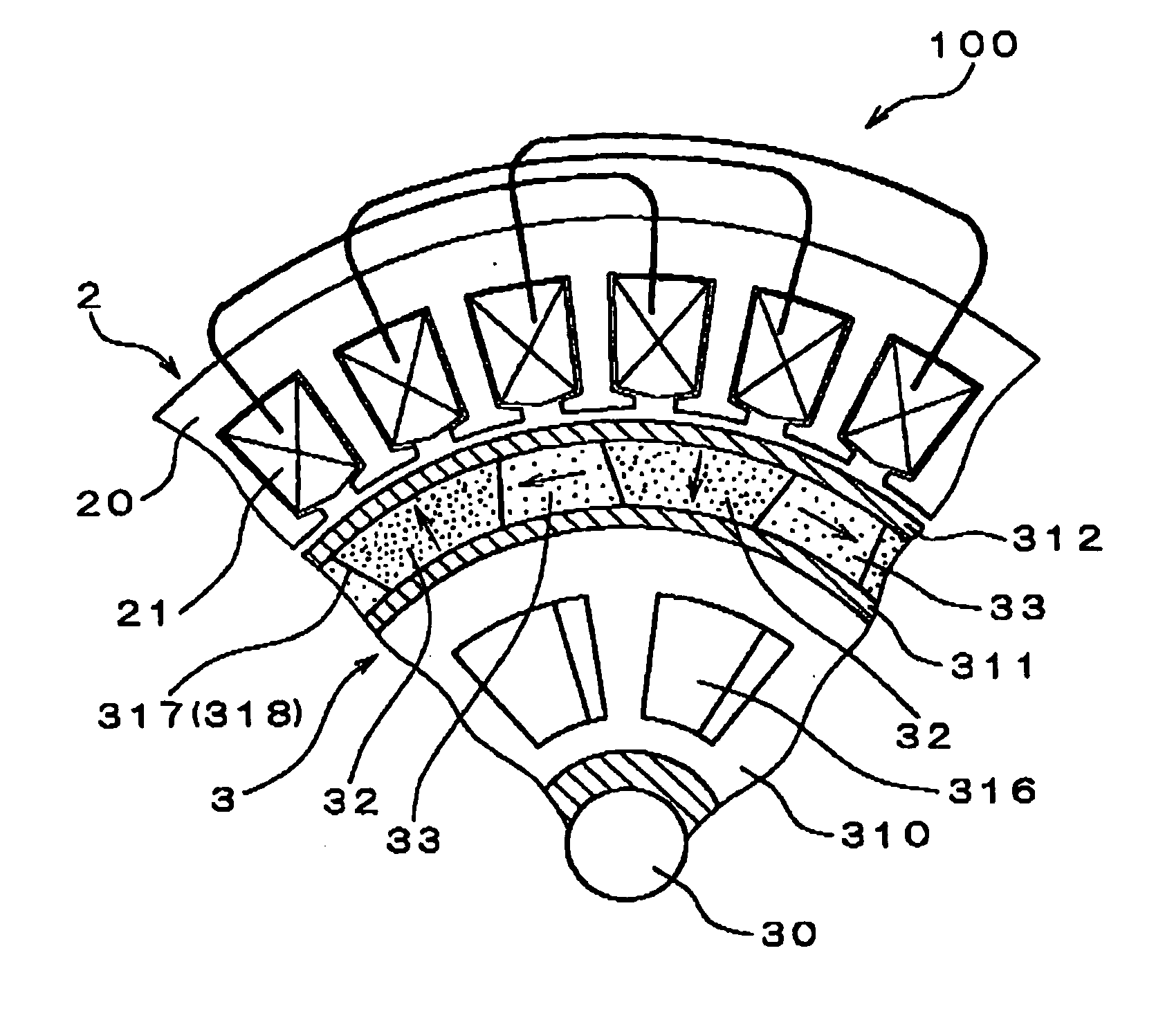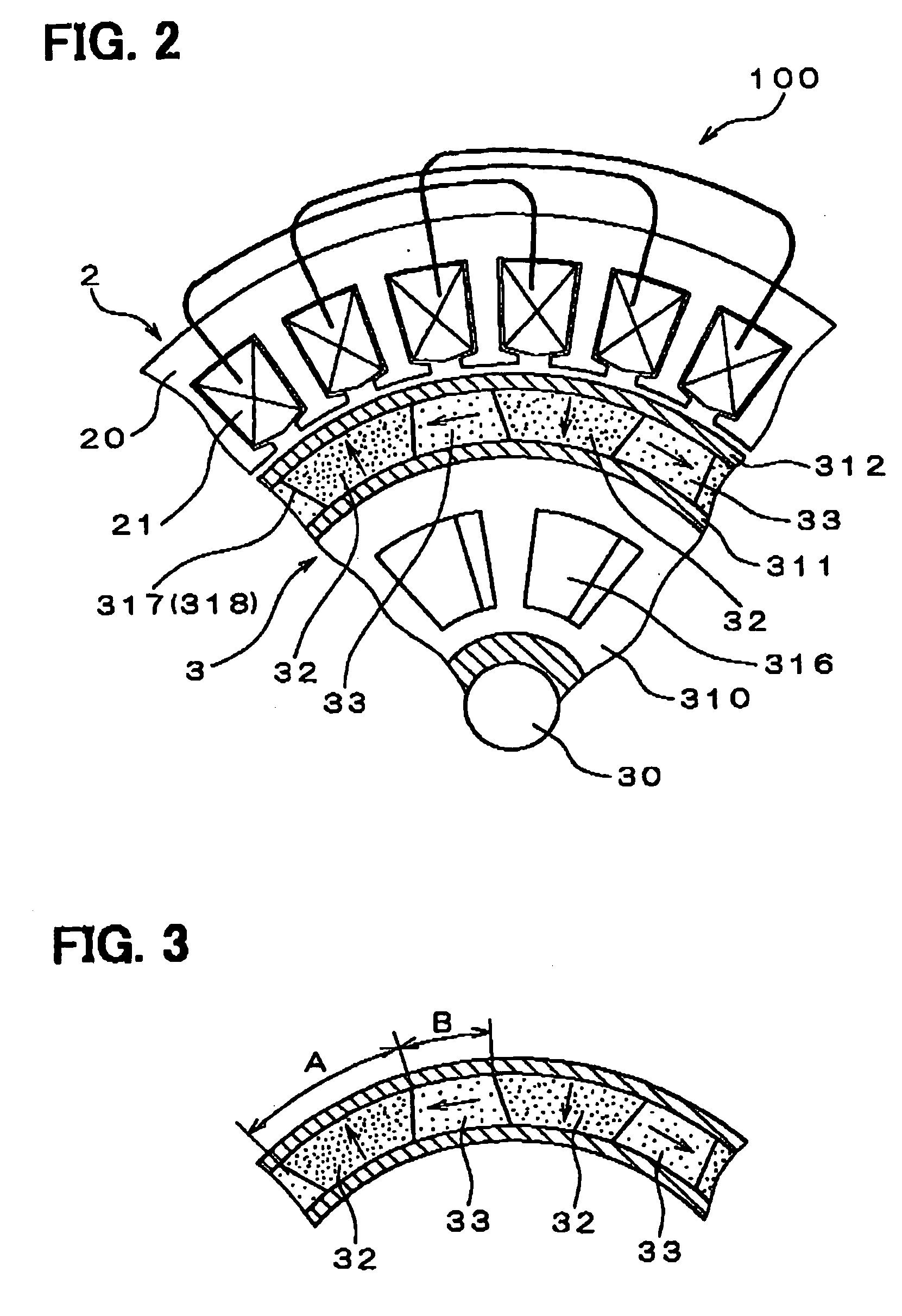Rotary electric machine and a rotor of the same
- Summary
- Abstract
- Description
- Claims
- Application Information
AI Technical Summary
Benefits of technology
Problems solved by technology
Method used
Image
Examples
first embodiment
[0033] (First Embodiment)
[0034] Referring to FIGS. 1 to 3, the present invention is for example employed to a vehicle ac generator 100. As shown in FIG. 1, the vehicle ac generator 100 includes a frame 1, a stator 2, and a rotor 3.
[0035] The stator 2 includes a core 20 made of a stack of core plates and a three-phase armature winding 21. The core 20 forms a plurality of teeth along its circumference, as shown in FIG. 2. The winding 21 is wound in each of slots defined between the teeth of the core 20. Furthermore, the winding 21 is wound in the slots in a pitch of 180° electrical angle so that three teeth are included in one pole pitch (180° electrical angle). The core 20 is housed and fixed to the frames 1 in a condition that an outer peripheral surface of the core 20 is cramped by an inner peripheral surface of the frame 1.
[0036] The rotor 3 is rotated to produce a rotating magnetic field linking to the stator 2. The rotor 3 is constructed of a rotation shaft 30, a hub 31, a pre...
second embodiment
[0061] (Second Embodiment)
[0062] In the second embodiment, general structure of the vehicle ac generator is similar to that of the first embodiment shown in FIG. 1. The vehicle ac generator of the second embodiment has a rotor 3A, which is different from the rotor 3 of the first embodiment. Thus, a description will be mainly made about the rotor 3A.
[0063] As shown in FIG. 5, the rotor 3A has main pole magnets 32A and yoke magnets 33A. The shape / size and materials of the main pole magnets 32A and the yoke magnets 33A are different from those of the main pole magnets 32 and the yoke magnets 33 of the first embodiment.
[0064] The main pole magnets 32A are formed of rare earth neodymium boron permanent magnets, similar to the first embodiment on the other hand, the yoke magnets 33A is formed of ferrite permanent magnets. In general, the ferrite permanent magnet has a magnetic flux density lower than that of the rare earth neodymium boron permanent magnet. Therefore, the circumferential...
third embodiment
[0065] (Third Embodiment)
[0066] In the third embodiment, general structure of a vehicle ac generator is similar to that of the first embodiment shown in FIG. 1. The vehicle ac generator of the third embodiment has a rotor 3B, which has a structure different from that of the rotor 3 of the first embodiment, as shown in FIG. 6. Thus, a description will be mainly made about the rotor 3B.
[0067] In the rotor 3B, a predetermined number of main pole magnets 32B and a predetermined number of yoke magnets 33B are arranged alternately in the circumferential direction. Each of the main pole magnets 32B are magnetized in a manner similar to the first embodiment. Also, the yoke magnets 33B are arranged such that the circumferential surfaces of each yoke magnet 33B are opposed to and abut the circumferential surfaces of the adjoining main pole magnets 32B. Here, an outside diameter of the main pole magnets 32B is smaller than the outside diameter of the yoke pole magnets 33B. Further, core pole ...
PUM
 Login to View More
Login to View More Abstract
Description
Claims
Application Information
 Login to View More
Login to View More - R&D
- Intellectual Property
- Life Sciences
- Materials
- Tech Scout
- Unparalleled Data Quality
- Higher Quality Content
- 60% Fewer Hallucinations
Browse by: Latest US Patents, China's latest patents, Technical Efficacy Thesaurus, Application Domain, Technology Topic, Popular Technical Reports.
© 2025 PatSnap. All rights reserved.Legal|Privacy policy|Modern Slavery Act Transparency Statement|Sitemap|About US| Contact US: help@patsnap.com



